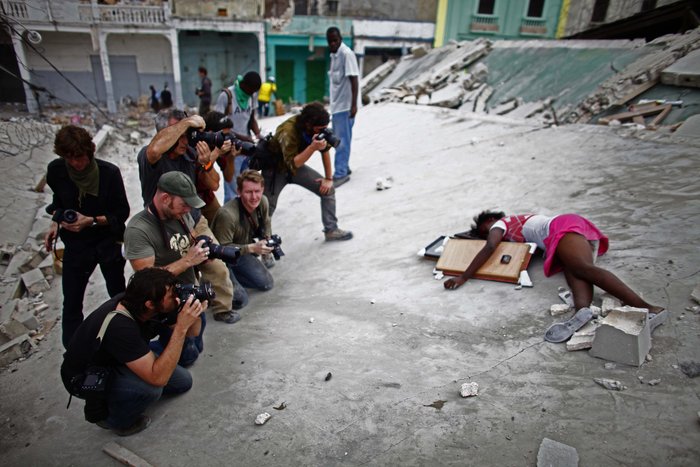
How Photography's 'Decisive Moment' Often Depicts an Incomplete View of Reality
Photojournalism can be like “trying to play Rachmaninoff while wearing boxing gloves,” as former photojournalist Simon Norfolk put it. One looks for the dramatic, the iconic, the universal, and in doing so the photographer then often simplifies the situation, removing it from a specific context that may help explain what the viewer will be seeing.
So it is in this photograph—the international press hovering like vultures next to the corpse. But what caused her death? What are they missing? Are they being callous? And what does the viewer need to know (but is not being told) about the circumstances surrounding this image?
The criticism of photojournalists as vultures is a familiar one. Kevin Carter, who won a Pulitzer Prize for his 1993 photograph of a struggling toddler trying to get to a feeding station in the Sudan with a vulture looking on, was widely branded as a vulture himself for not picking up the girl and helping her. He responded that as a photojournalist his duty was to witness, and if he were to physically help there were so many children in dire straits that he would no longer be able to photograph. Many argued that Carter’s photograph did a great deal to publicize the perilous position of these Sudanese so that governments and NGOs might help, and its selection for a Pulitzer should have been celebrated rather than criticized. But soon after his award, beset by a variety of unresolved personal issues, including drug addiction and guilt, Carter committed suicide.
But would more context have helped—for example, showing the many other starving children that Carter had photographed in the Sudan? Was a single photograph sufficient? In the case of this photograph by Nathan Weber, we know that the image depicts “A group of international photojournalists [who] d ocument the death of Fabienne Cherisma, who was shot in the head Monday, January, 19, 2010 during looting following the catastrophic earthquake that struck the Haitian capital of Port-au-Prince.” But is that enough?
It turns out that Weber has much more to say on the issue of Fabienne Cherisma’s death. In the days before online media, the press might have published this single photograph and a short caption and left it at that. But if one goes to Weber’s personal website, one can see that he made another striking photograph of this young girl. Here, in an image full of agitated movement, Cherisma is shown with two men who might, or might not, be trying to help, and several other people in the background, one carrying a folding chair that seems still to be wrapped in plastic, another holding a bundle up over his head, and others just watching. On a computer screen it is now possible (if media companies want to be just a bit adventurous) to show the photograph that is published here, and then click on this image to see the second photograph of people in what appears to be the moments after her death.
Or, even more helpful, would be to have the option of seeing the short video on Weber’s website that describes the context in which she was killed—police were allowed to shoot in the air to scare looters, but were so overwhelmed by the chaos around them that they sometimes shot and killed people. The video also shows the overwhelming grief of some at Fabienne’s death, perhaps members of her family. Rather than simply an icon of senseless death, the two photographs together with the video amplify our understanding of the circumstances, as well as asserting the humanity of the young woman as an individual with a history and with relationships.
The digital environment allows for much more context—but we continue to display imagery on screens in very similar ways to print publications, highlighting a single photograph when there is much more information and context to be shared. The criticism of photographers as monomaniacal, attracted primarily by the spectacle of death and violence, is in effect a criticism of the media’s overly simplistic use of photography when it is capable of so much more. Given all the many digital tools at hand, it is a pity that the interested reader is not given more to think about.